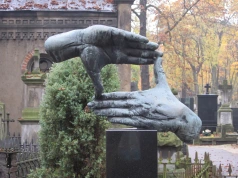• (1996) Szymanowski: Violin Concerto no.1
Karol Szymanowski: Violin Concerto no.1
programme note written for
BBC Philharmonic Orchestra
Manchester, 17 April 1996
Karol Szymanowski (1882-1937) was Poland’s most significant composer of the first half of this century. His earliest works, such as the Concert Overture (1905) and the Second Symphony (1910), show the influence of Richard Strauss and Scriabin. The music from the period of World War I, such as the Third Symphony (1914-16), reveal not only Szymanowski’s newly-acquired love for Mediterranean and Near Eastern culture but also the persuasive influence of Debussy and Ravel. The First Violin Concerto (1916) is also bathed in this atmosphere.
Throughout his life, Szymanowski tussled with the opposing mythic figures of Dionysus and Apollo. Here, Dionysian sensuality reigns. The Concerto unfurls like a fantasy, an impressionistic tone poem whose moods and motifs seem to ebb and flow at will but whose underlying structure is artfully created. Szymanowski drew inspiration, not for the first time, from a poem (May Night) by his near-contemporary, Tadeusz Miciński, who was fascinated by the occult and mysticism: ‘Donkeys in crowns settle on the grass – fireflies kiss the wild rose – while death flickers over the pond and plays a wanton song’.
The Concerto’s opening is a marvel of delicate movement, its colours and nuances utterly captivating, reflecting the surreal world imagined by Miciński. From its first entry, the solo violin dominates the texture, but with subtlety and suggestion rather than any grandiose statement. It soars above the orchestra in a state of unearthly ecstasy, by turns puckish and melancholic. In a letter to the concerto’s dedicatee, Paweł Kochański (who had worked closely with the composer on the solo part but who was, unfortunately, unable to give the first performance), Szymanowski described the Warsaw premiere in November 1922: ‘It is just wonderful on the full orchestra, surpassing all my expectations. The sound is so enchanting that the most musical people here went absolutely crazy about it. And imagine, Pawełeczku, the violin is constantly on top! There are perhaps only three or four bars where it is covered by the orchestra! It is my greatest triumph.’ Only at the very end, after Kochański’s cadenza, does the orchestra have anything like a real peroration (with one of the work’s more neo-romantic motifs), but this fades away as the solo violin recalls a particularly poignant idea and the concerto vanishes like a firefly into thin air.
© 1996 Adrian Thomas
☚
PROG NOTES
(repertoire list)
